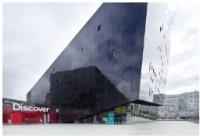 Add My Company
Add My Company
Sign In

In January 2018 BS8300:2009 was superseded by BS 8300-2, with the introduction of BS 8300-1 alongside it. Part 1offers the first comprehensive design guidance for new public spaces. In this helpful blog, we’ve outlined the new standard and where outdoor lifting appliances can play their part.
1. Introduction
The new standard BS 8300-1:2018 Design of an accessible and inclusive built environment (external), brings advice together to provide a definitive code of practice on inclusive and accessible design for the external built environment. As such, and along with other Building Regs, it is incredibly useful for anyone in the planning, design or management of an external environment.
Whilst not as prevalent as their indoor cousins, within the external environment there are lifting appliances equipped for outdoors. These can range from escalators and lifts on railway platforms, to stairlifts on a historic site and even platform lifts outside offices. In fact, you’d be surprised how many there are. But there’s also some extra considerations when specifying external lifts to enable public access and we’ve helpfully outlined them below.
2. What does the new BS8300-1 standard do?
Used in the production of Local Development Frameworks, client’s briefs and contract documents, this standard gives recommendations for the design of the external built environment, including the approaches to buildings, to accommodate users in an inclusive way.
The standard highlights guidance around key external features associated with a building or block of buildings, such as public facilities, parking provision, access routes, entrances around buildings, street design and landscaping, as well as horizontal and vertical movement (which is where a lift or escalator can play their part!).
It’s worth noting that this standard refers to internal design but it’s counterpart BS8300-2 gives the main recommendation. BS8300-1 does not give recommendations for the maintenance and management of the external environment (but does give a list of considerations in the Annex).
The information in the standard predominantly applies to new developments but can also be used for assessing the accessibility and usability of existing external environments to identify improvements and determining changes to heritage sites on a case-by-case basis.
3. Where are lifting appliances used outdoors?
External lifts and escalators can provide an alternative to stepped access to a building – from the conventional outdoor passenger lift or slow speed lifts, to external platform lifts and outdoor wheelchair stairlifts. Moving walkways can be used to shorten user journeys in lengthy horizontal areas. Where horizontal access is a lift, BS8300-1 recommends that wherever practical, conventional passenger lifts are the preference.
For all types of outdoor lifts and lifting appliances the standard recommends referring to BS8300-2, however it also proposes some additional considerations around weather protection - recommending that the standards required for environmental conditions, such as temperature, humidity, sun or wind exposure, snow or corrosive atmosphere (e.g. coastal areas) are discussed as part of the product specification to ensure safe and reliable operation.
4. Specifying external lifting appliances
It’s worth stating that most outdoor lifts have external entrances at all levels. There are instances where either a weather-proof shaft or structure is built adjacent to the building to accommodate an internal lift or an external lift with a mix of internal and external entrances. In these instances, Part L - conservation of fuel and power, which controls the insulation values of buildings elements, is worth referring to.
There is an optimal temperature range for the working of any type of lift appliance which is specific to the product. This is particularly true of platform lifts that are in their own structure, rather than an insulated shaft.
In general, the non slip properties of floors of lift cars, carriers of lifting platforms and steps of escalators/moving walks should be sufficient for the levels of moisture that are to be expected in an external environment.
On top of general considerations for lifting appliances in external environment there are specific design considerations for each product type which we’ve outlined below. Although the best source of guidance is the British standard for each lifting device alongside the other building regulations, including Part M, Section 4.2 and the Equality Act.
For more information on External Lifts & the New BS8300-1 Design Guidance talk to Stannah Lifts
Enquire Now
More Blogs
List your company on FindTheNeedle.

